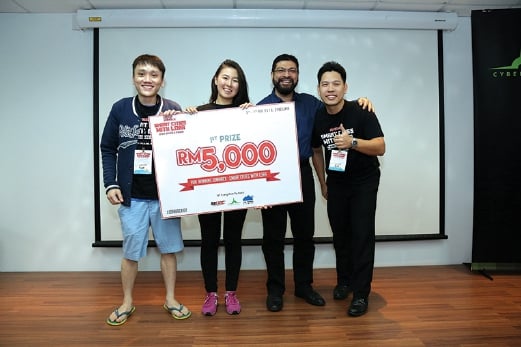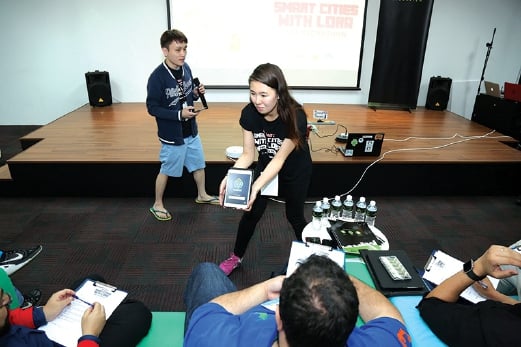At the JomHack hackathon, teams came up with solutions for everyday problems in smart cities, writes Hanna Sheikh Mokhtar
HARNESSING technology to solve real-world problems is the way forward for smart cities. With that in mind, Cyberview, in collaboration with TTN - The Things Network (Netherlands), Pixaworks Creative and Malaysia Digital Economy Corporation (MDEC) organised a 24-hour Internet of Things (IoT) hackathon recently.
The JomHack: IoT For Smart Cities With LoRa (short for Long Range) was aimed at developing usable IoT solutions which can be adopted and implemented in smart cities, in particular Cyberjaya.
Mahadhir Aziz, Cyberview’s head of technology hub development division, said: “Innovation is at the heart of our daily life here in Cyberjaya.
“We are proud to be part of a movement that can improve the community’s living experience in the long term. We hope these ideas will be developed to become enablers and key elements of our smart city vision which is driven by a culture of innovation and supported by unparalleled connectivity, sustainability, security and liveability.”
MDEC chief executive officer Datuk Yasmin Mahmood said: “The IoT represents the next frontier of Information Technology, with tremendous new capabilities waiting to be explored. With JomHack, we are a step closer to transforming the nation and fundamentally reshaping the way our cities operate. Through the partnership with Cyberview Living Lab, The Things Network and the ideas we see brought to life by the participants, we look forward to planning the future of our connected Malaysia.”
TTN, a global, open, crowd-sourced Internet of Things data network with over 200 communities worldwide, provided LoRa technology. LoRa technology is a signal modulation technique that provides long-range communication link for low-power wide-area network which can reach up to three kilometres in urban areas and over 15km in suburban areas.
THE COMPETITION
The three-day event saw the participation of 30 teams comprising three members each, with various computer programming, application development and engineering backgrounds, to develop IoT solutions around the Smart Cities theme. From this, 10 winning projects were shortlisted.
The winning project by Team 20 – The Water Leakage Detection System — makes use of IoT and LoRa to detect the loss of water flow in a pipe using sound sensors placed at strategic points in the system.
What exactly is a water leakage detection system and how does it work?
Leong Yok Tien, leader of Team 20, explained: “Imagine an ordinary straight pipe... water flow from each end has to be identical. If there is a difference, we can conclude that something has happened in between the pipe and it is most likely a leakage.
“By attaching a sound sensor at each end of the pipe, with no alteration being done to any existing pipe, we can measure the flow of the pipes. With LoRa, we can monitor the water flow in real time. In a real world situation, the pipes come in different length, size and material, so we can implement big data analytic by collecting and analysing the sound of the flow. We can also possibly do profiling as the two sensors can be self-calibrated to match any type of pipe. All in all, the solution is simple, cheap and can be scaled quickly compared to the traditional method.”
Other projects that made it to the top list were a Water Quality Monitoring application and a Smart Car Park Management System.
TEAM 20
Apart from Leong, a self-professed hackathon junkie, Team 20 members included Ng Kok Kwan, a business strategy management consultant who taught himself how to code, and Adel Maratova, a second-year computer software student from Asia Pacific University.
Ng does most of the back-end for software part, while Maratova works with Arduino (an open-source electronic prototyping platform which enables users to create interactive electronic objects).
Leong focuses on UI/UX (User Interface and User Experience) design and does a little software designing as well.
“I have always wanted to build something that had huge positive impact on humanity and this is one of my many projects that does that,” he said.
He is a hackathon veteran, having entered 20 of such events before JomHack. Some of his past projects are SolarFlare (which he worked on with Ng) and Alexis, an app that acts as a goal-oriented wealth assistant.
The idea for the Water Leakage Detection System came from Ng, who experienced water leakage in a toilet bowl at home and wondered if technology could help solve the problem. The team further researched on the severity of the problem in the country and came up with the idea to install an IoT device on water pipes to continuously monitor the condition of water pipes.
GLOBAL INCLUSION
For many JomHack participants, the opportunity to learn about LoRa was what prompted them to sign up for the event. As Leong put it, “Learning LoRa technology will benefit us. This is the most technical project we have worked on in a hackathon. We built a 10-stack development with IoT (Arduino with LoRa) to Mobile app layer within 24 hours. We are exhausted but very satisfied with what we have created.”
The Things Uno used by the teams in JomHack is an Arduino-based board with LoRa connectivity. Developed and produced by TTN, the board has several general purpose input and output pins that let the developers and hobbyists put additional sensors or modules for applications development.
TTN co-founder and technology lead Johan Stokking said: “Part of becoming a smarter city involves setting up the right opportunity and infrastructure to invite community participation. JomHack certainly hits its mark with these brilliant pitches from talents all over the country. Everyone here is, without a doubt, the best hackathon participants I have ever seen.”
Stokking flew in all the way from The Netherlands to mentor the teams. With his help, Leong said, the team was able to learn the hardware quickly.
Stokking started programming at the age of 12, and is a graduate of Industrial Engineering and Management with a major in Information Engineering. He founded The Things Network with Wienke Giezeman last year, focusing on technical strategy, managing the development team, product development, developer experience and workshops.
CHALLENGES
Although Team 20 is fortunate to have MDEC scheduled follow-up meetings with companies to explore the opportunity to deliver the project, there are still lots of hypothesis that they need to validate.
Leong said: “We can’t just dig the road and instal our sensors on the pipes, right? For now, it will depend on water distribution-related companies and agencies. We hope they can put aside their differences and focus on solving this issue.”
The water leakage detection system is indeed an innovative green solution to an age-old problem. Hackathon events such as JomHack can have a great impact on IoT adoption growth in the country and serve as a good platform for participants to develop useful applications for smart cities.








